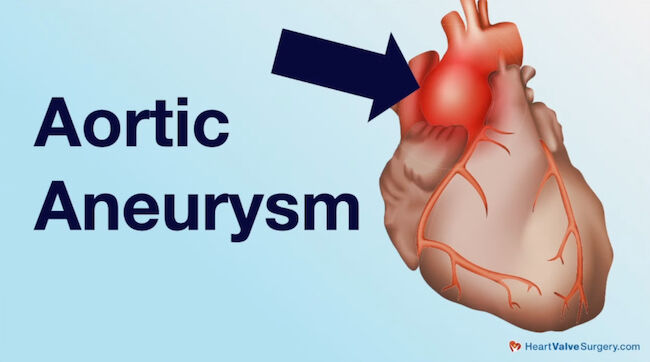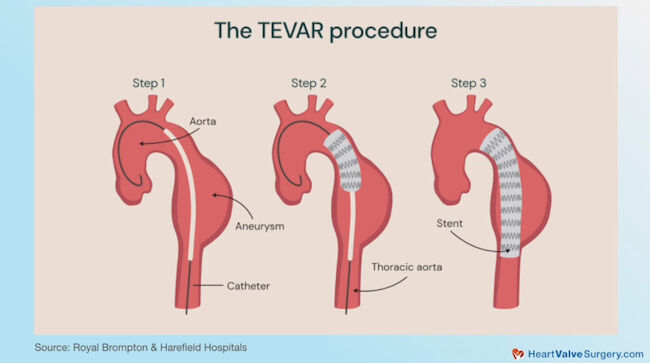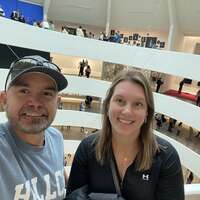Surgeon Q&A: Can Aortic Aneurysms Be Repaired Via Catheter?
Written By: Allison DeMajistre, BSN, RN, CCRN
Medical Expert: Chris Malaisrie, MD, Professor of Surgery, Co-Director of the Heart Valve Center and Thoracic Aortic Surgery Program, Northwestern Medicine
Reviewed By: Adam Pick, Patient Advocate, Author & Website Founder
Published: November 13, 2024
Health professionals often describe an aortic aneurysm as a “silent killer” since it often doesn’t cause patients pain or adverse symptoms and is frequently found by chance during an imaging test for a different problem. Once the aneurysm is diagnosed, however, patients don’t see it as a “silent killer” and instead typically describe it as a “ticking time bomb” inside of their chest. That’s because an aortic aneurysm, without proper surveillance, can either rupture or cause a dissection, both of which are life-threatening situations.

Northwestern Medicine’s patient education guide about cardiac surgery for aortic aneurysms explains that an aneurysm develops when the aortic wall weakens, creating a bulge at the weakest spot. The bulge starts small, but over time, pressure from blood pumping out of the heart causes the aneurysm to grow. Surgeons usually require surgery once an aneurysm is greater than 5.5 centimeters. In the presence of a bicuspid aortic valve, however, the criteria is 5 centimeters, and in genetic disorders like Marfan’s Syndrome, the requirement for surgery is 4.5 centimeters.
Several types of surgery can be performed to repair an aortic root aneurysm, including aortic valve and root replacement or valve-sparing aortic root repair. Both surgeries often require an open heart procedure which often leads patients to wonder about the possibility of minimally-invasive techniques for aneurysm treatment. To this point, we received a patient question from Jeff who asked, “Has there been any progress made on fixing aortic aneurysms via catheter? I heard there may be a method where a material is inserted in the aorta at the aneurysm site to keep the aneurysm from expanding.”
To learn the answer to Jeff’s question, we met with Dr. Chris Malaisrie while attending the Annual Meeting of The Society of Thoracic Surgeons. Dr. Malaisrie is a leading aortic valve and aneurysm specialist at Northwestern Medicine in Chicago, Illinois, who has successfully treated many patients in our community.
Key Learnings About Aortic Aneurysm Repair Via Catheter
Here are important medical insights about the minimally-invasive treatment of aortic aneurysms:
- Not all aneurysms need open heart surgery. Dr. Malaisrie said, “Sometimes aneurysms need to be treated, but they do not all need to be treated with open surgery. Some patients can get a treatment called thoracic endovascular aortic repair. You hear TEVAR, often said T-E-V-A-R, and that’s a procedure that doesn’t involve open incisions. We can deliver a graft through the groin artery and deploy the endovascular stent graft inside the aorta. It’ll align the aorta, exclude the aneurysm from the circulation, and prevent it from rupturing.”

- For patients with an aortic aneurysm who also need their aortic valve replaced, is there a combination TEVAR and TAVR, or is that prohibitive? “We also have that procedure for patients with aortic valve disease,” said Dr. Malaisrie. “Imagine a stent with a valve inside it. The stent is made out of metal and some fabric. The valve is a working valve. We can also crimp that onto a very small catheter that is also delivered through an artery, usually from the groin, and we can deploy that valve inside the heart without open heart surgery.”
- Can the TEVAR and TAVR procedures be done simultaneously during one operation? “Both procedures can be done at the same time,” said Dr. Malaisrie. “We try to avoid it. If the patient has aortic stenosis, we’re going to do the TAVR first. If the patient has an aneurysm, that will follow after the treatment of aortic stenosis.”
Thanks Dr. Malaisrie and Northwestern Medicine!
On behalf of Jeff and all of the patients in our community and all over the world, many thanks to Dr. Malaisrie for everything you and your entire team at Northwestern Medicine are doing for heart valve and aneurysm patients everywhere!
- Surgeon Spotlight: Dr. Chris Malaisrie
- Aortic Valve Reconstruction Surgery: Patient Advantages
- Can A Bicuspid Aortic Valve Be Repaired If An Aortic Aneurysm Is Present?
Keep on tickin,
Adam
P.S. For the deaf and hard of hearing members of our community, we have provided a written transcript of the video interview with Dr. Malaisrie below.
Video Transcript:
Adam: Hi everybody, it’s Adam with heartvalvesurgery.com. We’re in San Antonio, Texas at the annual meeting of The Society of Thoracic Surgeons. I am thrilled to be joined by Dr. Chris Malaisrie, who’s a leading aortic valve and aneurysm specialist at Northwestern Medicine in Chicago, Illinois. Dr. Malaisrie, you and I have known each other for a long time. It is great to see you again, and thanks so much for being with me today.
Dr. Malaisrie: Thank you very much, Adam.
Adam: Yeah, so we are answering patient questions here at the conference, and we got a great one that just came in from Jeff. Jeff asks, “Has there been any progress made on fixing aortic aneurysms via catheter? I heard there may be a method where a material is inserted in the aorta at the aneurysm site to keep the aneurysm from expanding”.
Dr. Malaisrie: Yeah, sometimes aneurysms need to be treated, but they do not need to all be treated with open surgery. Some patients can get a treatment called thoracic endovascular aortic repair. You hear TEVAR, often said T-E-V-A-R, and that’s a procedure that doesn’t involve open incisions. We can deliver a graft through the groin artery and deploy the endovascular stent graft inside the aorta. It’ll align the aorta, exclude the aneurysm from the circulation, and prevent it from rupturing.
Adam: I’ve got to ask you a follow up, Dr. Malaisrie, from a patient. I also need my aortic valve replaced. Is there a combination TEVAR and TAVR, or is that prohibitive?
Dr. Malaisrie: We also have that procedure for patients with aortic valve disease. Imagine a stent with a valve inside it. The stent is made out of metal and some fabric. The valve is a working valve. We can also crimp that onto a very small catheter that is also delivered through an artery usually from the groin, and we can deploy that valve inside the heart without open heart surgery.
Adam: It’s fascinating the innovation that you’re doing in Northwestern Medicine. I just want to make sure, can you do both procedures at the same time during one operation?
Dr. Malaisrie: Both procedures can be done at the same time. We try to avoid it. If the patient has aortic stenosis, we’re going to do the TAVR first. If the patient has an aneurysm, that’ll follow after the treatment of aortic stenosis.
Adam: Great. Dr. Malaisrie, on behalf of all the patients in our community, patients all over the world, thanks so much for everything you’re doing at Northwestern Medicine.
Dr. Malaisrie: Thank you very much, Adam.
Adam: Hi everybody, it’s Adam. I hope you enjoyed that video. Don’t forget, you can always subscribe to our YouTube channel, watch the next two educational videos coming up on your screen, or click the blue button to visit heartvalvesurgery.com.




